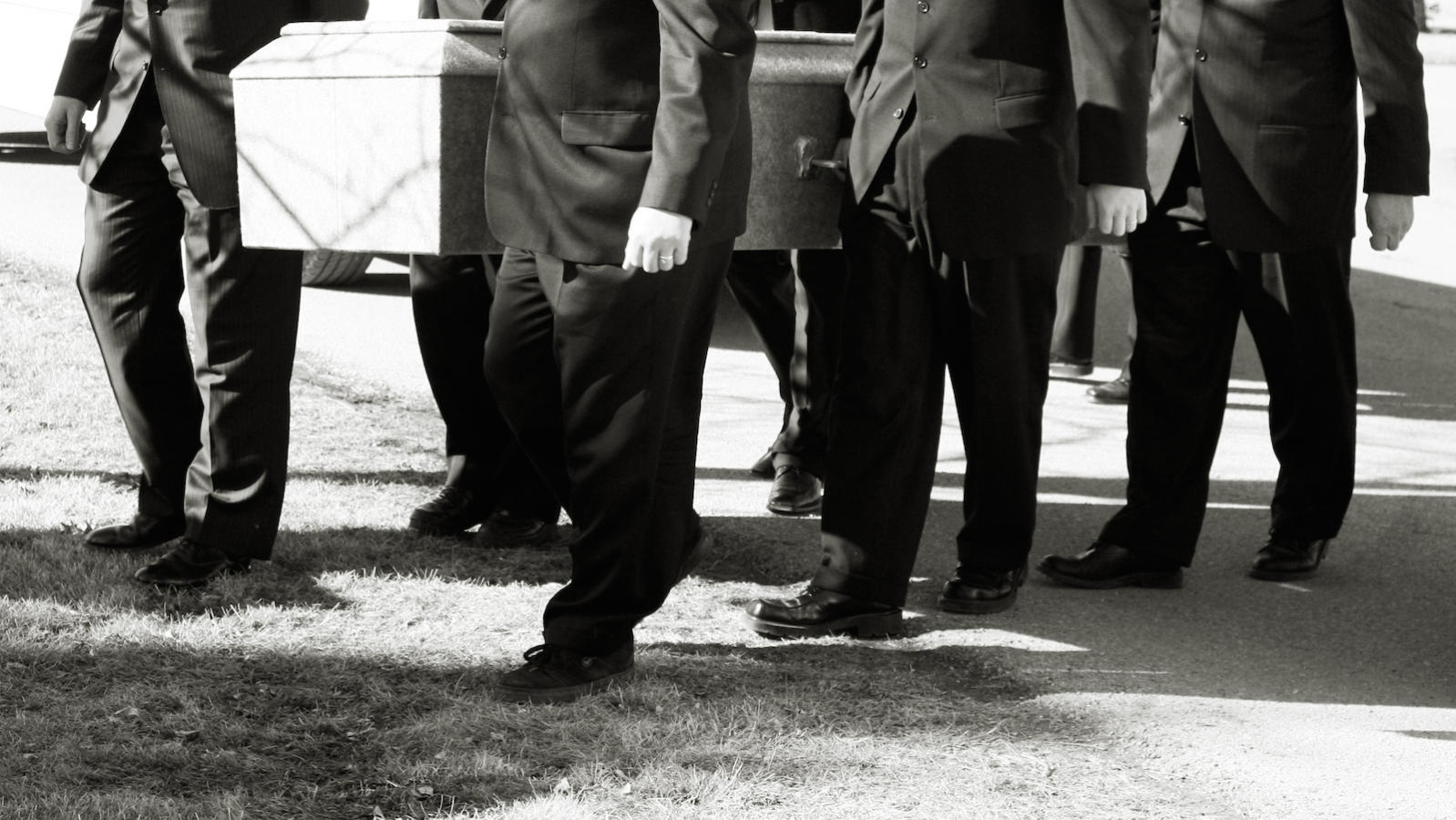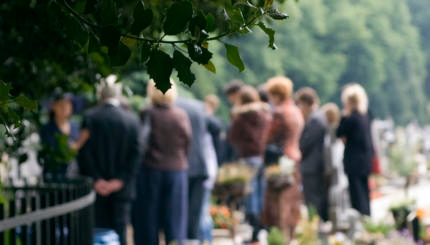The time preceding a funeral (called “aninut“) is often the most difficult for mourners. On the one hand, they are not yet in the period of formal mourning, which begins immediately after the funeral; on the other hand, they are already grieving. Friends and family members must be notified. Funeral details must be worked out, if they have not been prearranged, and eulogies prepared.
Funerals are usually arranged by families in consultation with a funeral home and/or chevra kadisha and a rabbi, as well as a cemetery. In some places, the chevra kadisha, funeral home and Jewish cemetery may be seamlessly integrated; even when this is not the case, the three organizations generally communicate well with one another but should be notified of which organizations are being used.
Learning these details (particularly, before they are necessary) can make this painful time less confusing. The traditional time frame for a Jewish burial is quite brief. In North America, burial usually occurs within about three days of the death. It is helpful for mourners know what to expect from centuries-old Jewish burial and mourning practices. Learn more about the Timeline of Jewish Mourning here and get answers to Frequently Asked Questions About Jewish Death and Mourning.
Contact a Chevra Kadisha and/or Funeral Home
When a Jewish person passes away, the first task is to inform either a funeral home or the chevra kadisha. A chevra kadisha is a Jewish burial society; it will quickly send representatives to gather the body. A hospital, care facility, synagogue, funeral home or rabbi should be able to help you contact a chevra kadisha if you wish to use one. Learn more Jewish death and mourning terms here.
A chevra kadisha and a funeral home are both mortuaries, groups that prepares the body for burial. A cemetery, by contrast, is the place where the body is buried. Sometimes the mortuary is part of the cemetery, in which case one needs only to contact the cemetery. However, sometimes people choose to use a chevra kadisha that is separate from the cemetery (either because it is more traditional, cheaper or for other reasons), in which case the chevra kadisha should be contacted first. In either case, the process moves more smoothly if arrangements have been made in advance, but either way it can all be handled in a timely manner.
A representative of the chevra kadisha may ask if there is someone available to stay with the body until they arrive. That is because in the Jewish tradition, a dead person should not be left alone until their burial. A shomer, or guard, will watch over the body, often while reciting psalms. Although a family member may be willing to serve this role, it is not necessary that the shomer (or shomeret, if a woman) know the deceased person (though it is often considered best if they are Jewish and can recite prayers or psalms). Once the chevra kadisha or mortuary picks the body up, they can provide someone to do this task.
Most often, the chevra kadisha or funeral home will arrange for transporting the body of the deceased. Depending on the local situation, the chevra kadisha will either conduct its work at its own facility or at a separate funeral home. Trained volunteer members of the chevra kadisha bathe and dress the body with extreme care and respect (this is called a Tahara). A traditional burial also includes dressing the body in a plain white shroud (known as Tachrichim) and placing it in an untreated simple wooden coffin. Other than the shroud, the only item traditionally buried along with the dead person is a tallit (prayer shawl) with one of its corner fringes cut. With some chevra kadishas the tallit is provided and cut automatically; with others it must be requested and paid extra for. Learn more about Tahara here.
Larger Jewish communities may have separate burial societies for each synagogue or Jewish denomination (Reform, Conservative, Orthodox). In such a situation, each chevra kadisha will have a slightly different approach to the laws and customs connected to body preparation and burial. For example, one chevra kadisha may allow the body to be dressed in clothing rather than a simple shroud. Choose the organization that best matches your family’s preferences.
There may not be a burial society in your hometown. In some areas, there may be a set protocol by which Jewish funerals are arranged, even if there is no official burial society or Jewish funeral home. Jewish burials in such areas may be arranged by local Jewish families, sometimes through a synagogue. In other places, it may be best to call the closest synagogue or Jewish federation — whether it is in the nearest major city or a neighboring state.
Find a Burial Plot or Make Other Arrangements for the Deceased
Jews are traditionally buried either in a specifically Jewish cemetery or in a part of a general community cemetery designated for Jewish use. Jews traditionally are not cremated. However, a number of Jewish families nonetheless opt for cremation, and many Jewish cemeteries, funeral homes and clergy members will work with them. Learn more about cremation here.
If it is necessary to choose a funeral plot, it is frequently best to consider if there is a cemetery that has been used for other family members. It may even be possible to find an available plot for the deceased near the graves of loved ones. Other considerations may include costs and proximity to living family members who may want to visit the grave occasionally. If the deceased or one of the mourners belongs to a synagogue, you may be able to purchase in the synagogue’s cemetery or cemetery section.
Find a Funeral Officiant
This officiant, usually a rabbi or cantor, does not need to be someone who knew the deceased person, although this is preferred by most families. Most often, the officiant is a rabbi who either leads a synagogue where the deceased person was a member or the synagogue of other family members. Funeral homes usually have a list of potential officiants who serve families that are not affiliated with a synagogue.
Usually, the rabbi (or other officiant) will lead the funeral prayers and deliver a eulogy. Learn more about Jewish eulogies here.
In order to prepare for these tasks, the officiant will generally meet with family members before the funeral, either in their own home or at the synagogue. The rabbi (or other officiant) will want family members to provide an accurate description of the deceased person and the lessons that may be learned from that person’s life. Also, family members will sometimes assist in the selection of readings for the service. It is crucial that the rabbi be contacted before the time of the funeral is set, to ensure that the rabbi will be available.
Arrange for a Traditional Meal (Meal of Consolation) after the Funeral
Many families, including some who are not observing shiva, welcome visitors at the family home after the funeral service for a traditional meal, called a “seudat havra’ah” (meal of consolation). This meal is the first food eaten by the family after the funeral and generally consists of simple, round foods, such as a hard-boiled egg, symbolizing the cycle of life. This meal is mostly intended for the mourners, who may feel too saddened to eat if left alone. The community is present to provide the food for the mourners, encourage them to take care of their own needs and usher mourners into a new stage in their lives. This is also a time in which mourners may light a large candle (usually provided by the funeral home), which will burn in the home for the next week.
In addition to that small meal for the mourners, some families hire a caterer to provide a meal while people gather at their home after the funeral. However, it is nice for extended family members, synagogue members, or friends to arrange the meal. Mourners should not have to arrange for the food, greet or entertain guests, but simply sit and reflect on their loved one, if they are up for it.
Plan the Shiva
Before the burial, priority should be given to arranging a respectful farewell to the departed loved one. Once these efforts are in place, attention should turn to the details of mourning. If mourners will be sitting shiva (i.e. observing the seven-day-long period of mourning in a family home), preparations must be made, usually with the help of a rabbi or synagogue members. (Some families may observe a three-day mourning period, some just one day, and others a full week.) This full week of withdrawal from daily concerns provides a chance for mourners to grieve together, exchange memories of the deceased loved one, and be comforted by each other and the community. Learn more about shiva here.
Funeral Checklist
Although the most vital tasks and decisions must be made by family members, an excellent way to deal with other tasks is to recruit as many friends and non-first-degree relatives (in-laws can be excellent for this) as possible to make phone calls, help transport out-of-town relatives, arrange food for the meal following the funeral, and assist with other needed errands.
Burial Arrangements
- Contact a chevra kadisha (burial society) and/or funeral home. If there is no local organization of this type, contact other local Jewish families, the closest synagogue, or Jewish Federation.
- If the departed person has a pre-arranged burial and funeral plan, find the necessary information.
- If the deceased owned a tallit (prayer shawl), decide if they should be buried with it. (It may also be kept as a family heirloom.)
- The displaying of flowers is generally discouraged at a Jewish funeral. Instead, choose an appropriate charity for people to make donations to in their memory.
Sharing the Sadness
- Inform–in person, if possible–the closest family members. For out-of-town members of the immediate family, do your best to make sure that the person being called is not alone or in an inappropriate location to receive the sad news of their loved one’s death. (For example, one should not notify a sibling that their sister has died while he or she is on their cell phone and driving.)
- Make a list of people who should be contacted regarding the death. Include family members, friends, employers (of both the deceased and of family members), co-workers, community members, and neighbors.
- Delegate family members and friends for making phone calls.
Funeral Service
- Contact the synagogue of the departed person and/or of the mourners.
- Decide who will conduct the funeral service.
- Consult with the service officiant regarding the eulogy and the participation of family members and friends.
- Estimate the number of funeral attendees.
- Consult with the funeral home and/or cemetery regarding service locations for both the eulogy and burial. Decide if a chapel and/or graveside service will suit family needs.
- Appoint pall-bearers (who will carry the coffin part or all of the way to the burial site). If there are individuals who may be unable to physically handle this task, you may designate them as “honorary” pall-bearers.
- Decide who will be asked to deliver eulogies and inform them.
- Prepare the eulogy one will deliver, if applicable.
- Arrange for transportation to and from the ceremony for mourners and other family members. This is often done through the funeral home.
- Some mourners may wish to practice reciting the Mourner’s Kaddish
- If mourners would like to rip a garment (usually a shirt or sweater) for kriah, then they should wear that article to the funeral (with appropriate garments underneath, for the sake of modesty).
- If children are to attend the funeral, arrange to seat them with a babysitter or other responsible adult who will not mind leaving the service if the children are restless or upset.
- Prepare a handout with the shiva information, to be passed out at the funeral, that includes the address of (and maybe directions to) the home where shiva will be observed, hours during which visitors will be welcomed, and the times of the services.
Seudat Havra’ah (“Meal of Consolation”)
- If the family will be observing this custom, the rabbi or members of the extended family or friends—but not the mourners—should make arrangements for a light meal.
- Give out directions to the family home at the funeral if that is the place the gathering will occur.
- Place a pitcher of water, a basin, and towel outside the front door, to be used by funeral returnees before they enter the home. (This may also be done outside the cemetery.)
- Prepare hard-boiled eggs for eating during the meal. These eggs symbolize the cyclical nature of life.
Shiva Checklist
- Notify employers of needs for family leave.
- Contact the synagogue of the departed person and/or of the mourners regarding the shiva, in order set a schedule of services, to assure 10 adults at services (if applicable), and to ask for assistance with other practical arrangements.
- Set a schedule for meal preparation by friends and extended family.
- Create a door sign with visiting hours posted.
- Notify neighbors of the presence of additional cars and people in the neighborhood.
- It can be helpful to have groceries and other necessary items delivered over the course of the week.
- If desired, borrow from the synagogue or funeral home low chairs or cushions for the mourners’ seating, prayer books for services, and kippot (head-coverings) for guests.
- For mourners who wish to observe all the shiva traditions (such as covering the mirrors in the home), more information is available here.
Other To Do’s
- Post an obituary in the local and/or Jewish newspapers. Obituaries may be posted either before or after a funeral.
- Designate a charitable organization(s) to receive donations in the name of the lost loved one.
Sign up for a Journey Through Grief & Mourning: Whether you have lost a loved one recently or just want to learn the basics of Jewish mourning rituals, this 8-part email series will guide you through everything you need to know and help you feel supported and comforted at a difficult time.
Looking for a way to say Mourner’s Kaddish in a minyan? My Jewish Learning’s daily online minyan gives mourners and others an opportunity to say Kaddish in community and learn from leading rabbis.
Kaddish
Pronounced: KAH-dish, Origin: Hebrew, usually referring to the Mourner’s Kaddish, the Jewish prayer recited in memory of the dead.
chevra kadisha
Pronounced: KHEV-ruh ka-DEESH-uh, Origin: Aramaic, Jewish burial society, a group of volunteers who prepare the body for burial and, in some cases, coordinate food and visitors for the mourners.
tahara
Pronounced: tah-HAH-ruh, Origin: Hebrew for purity, the ritual cleansing of a dead body in preparation for burial.
tallit
Pronounced: tah-LEET or TAH-liss, Origin: Hebrew, prayer shawl.
shiva
Pronounced: SHI-vuh (short i), Origin: Hebrew, seven days of mourning after a funeral, when the mourner stays at home and observes various rituals.



